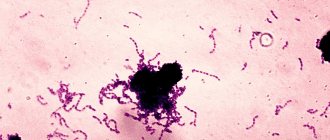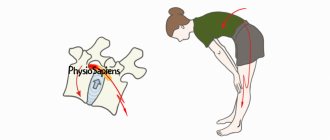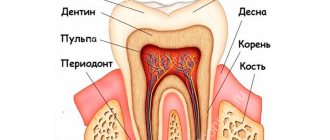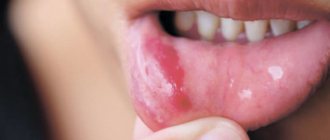White, foul-smelling balls in the tonsils
These are tonsillar plugs or stones; they form in the lacunae - the recesses of the tonsils. Their color, size, shape, and consistency depend on the composition. Most often, white lumps of soft consistency are observed; in some cases, if the composition contains calcium compounds, the lumps can be dense.
White lumps in the lacunae are formed from exfoliated old mucosal cells, bacteria and a small amount of food debris. Sometimes the lumps contain pus, and then they acquire an unpleasant odor and a yellowish tint.
You should know! When white and yellow lumps appear, a person experiences a sensation of the presence of a foreign body in the tonsils, a sore throat and bad breath.
Reasons for appearance
Experts say that the appearance of white lumps in the throat is a consequence of an inflammatory process, for example, chronic tonsillitis. This is an infectious pathology that develops against the background of weak immunity.
Provocateurs can be:
- sore throats that have not been fully treated;
- frequent consumption of cold drinks;
- ARVI and acute respiratory infections;
- smoking;
- alcoholism;
- stress;
- lack of work and rest schedule;
- bad ecology;
- work in hazardous production.
Chronic tonsillitis is caused mainly by streptococci and staphylococci, but sometimes this process can be triggered by:
- chlamydia;
- microplasma;
- viruses;
- Candida fungi.
However, the exact reasons for the appearance of white lumps in the throat are not fully known, since in some people they appear during an exacerbation of tonsillitis, while in others they do not.
According to statistics, more often white lumps appear in the throat of men.
When is surgery necessary?
If left untreated, pathogenic bacteria can infect the tonsils so severely that over a certain period of time they cease to perform their barrier function and become a source of infection, from where it spreads throughout the body and can cause damage to other organs.
In such situations, huge plaques form on the tonsils, white lumps regularly come out of the throat, smelling disgusting, and the patient is constantly plagued by discomfort in the throat.
In such situations, conservative therapy often no longer produces the expected results, and the otolaryngologist may recommend the patient to remove the tonsils.
This operation is called tonsillectomy.
This surgical intervention is performed under local anesthesia and can be performed either by classical surgery or by more modern methods: laser, radiofrequency ablation, etc. The procedure takes little time and is characterized by a short and simple recovery period.
If white balls periodically or regularly come out of your throat, you should consult a doctor who will prescribe a course of antibacterial drugs. However, to prevent relapse, a number of additional measures need to be taken.
If the formations on the tonsils are large enough, located too deep and cause discomfort, and also appear on the tonsils again after drug therapy, surgical intervention may be required. Under local anesthesia, the doctor will remove the plugs and also clean the surface of the tonsils.
Possible complications
Since the function of the tonsils is a barrier - they protect the lower respiratory tract from the penetration of pathogenic flora into them, a failure in their work can lead to a large number of negative consequences. In addition, healthy tonsils are directly involved in the synthesis of lymphocytes and in the regulation of immune processes. When the tonsils are damaged, they begin to work against their own body and damage target organs:
- heart – rhythm disturbances, myocarditis, endocarditis, tonsillocardial syndrome, etc.;
- kidneys – nephritis, pyelonephritis, glomerulonephritis;
- liver – cholecystitis, toxic hepatitis;
- joints;
- genitourinary organs.
Systemic pathologies such as:
- rheumatism;
- psoriasis;
- polyarthritis;
- neurodermatitis and so on.
In some cases, the pathology may be complicated by a peritonsillar abscess, which requires immediate treatment in a hospital setting.
Important! After a sore throat or tonsillitis, it is necessary to donate blood and undergo a cardiogram in a couple of weeks in order to exclude the acquisition of another chronic disease due to tonsillitis.
Symptomatic manifestations
Chronic tonsillitis is accompanied by the following symptoms:
- Expectoration of white or purulent lumps with a foul odor. White and yellow stinking balls are coughed up not only when coughing and sneezing, but sometimes even during normal conversation. In most cases, they are no larger than a match head, but they can be quite large.
- White plaques can be observed on the surface of the tonsils, but it happens that they are concentrated in the deep layers and remain invisible.
- The patient complains of a constant sore throat, especially in the morning; sometimes this symptom can be so pronounced that the person begins to choke.
- Sore throat and redness prevent a person from swallowing saliva normally, and then food and water.
- Discomfortable sensation of the presence of a foreign body in the tonsil area, many complain of the sensation of a large lump in the throat.
- An unpleasant odor from the oral cavity, most often it is so pronounced that it can be felt by people around.
- Enlarged cervical lymph nodes.
- General malaise, aches.
- Unproductive cough - a person tries to clear his throat, but he does not always succeed.
White lumps are not always cleared up when coughing; it can also be a thick mucous mass. Its jelly-like consistency makes it difficult to cough up completely. However, a person may not be bothered by any other signs other than lumps leaving the throat .
Reasons for the appearance of lumps
Patients often complain that white lumps fly out when they cough. This symptom can appear for a variety of reasons. Most often it is pathological. However, in some cases it may not pose any risk to human health.
Experts say that men are most often affected by the disorder. In women they appear much less frequently.
A cough with white lumps is often caused by tonsillitis.
Patients who have white lumps on their tonsils mistake them for food debris. This suspicion is wrong. Most often, white lumps are a clear sign of chronic tonsillitis. This is an inflammation of the infectious type, which can become chronic when the body's protective functions are reduced. The most susceptible to this disease are:
- patients who frequently experience respiratory illnesses;
- people who often consume cold food and drinks;
- patients who often face stressful situations and have chronic fatigue;
- smokers and people who regularly drink alcoholic beverages;
- people who work in various industrial enterprises or regularly come into contact with large quantities of chemicals;
- people living in a heavily polluted area.
Constant stress and overwork can contribute to the development of tonsillitis
White lumps often appear in smokers. This is not always a sign of chronic tonsillitis. Such a violation may indicate that a person has had a bad habit for a long period of time and certain changes have occurred in his body. In this case, there will be no plaque on the tonsils. To get rid of this disease, it will be enough to quit smoking. In some cases, the symptom may be pathological, so if it appears, you must visit a doctor.
With tonsillitis, the discharge has an unpleasant odor that is difficult to miss. They consist of pus, food debris and dead cells. The size of the lump can vary from 1 mm to 1 cm. This depends on the degree of neglect of the disease and its course. Some patients may experience purulent plugs larger than 1 cm.
White lumps are often present in people who have recently had a cold. The disorder does not require special treatment if the discharge does not have an unpleasant odor.
White lumps may appear when coughing in smokers; they are also more prone to tonsillitis.
If there is a smell in white lumps, there is no doubt that the cold has provoked complications and turned into chronic tonsillitis.
Why do you need to get rid of them?
Since the presence of white lumps in the throat negatively affects the state of the human immune system, and they can give impetus to the development of complications and chronic pathologies of target organs, it is imperative to get rid of them.
Keep in mind! In addition to the complications listed above, the balance of microflora in the oral cavity is disrupted, and pathogenic microorganisms begin to actively multiply. At the same time, they can penetrate the organs of the digestive tract and provoke ulcers, dysbacteriosis and other pathologies.
General approach to therapy
To clarify the diagnosis, the patient is prescribed:
- general blood analysis;
- immunogram;
- ECG;
- Analysis of urine;
- throat swab.
Based on the results of these studies, the doctor can determine the severity of the pathology and select a treatment regimen that is appropriate to the situation.
The patient must be prepared for the fact that the treatment will be quite long and complex. The treatment regimen is prescribed in several directions at once :
- strengthening the immune system;
- gargling and rinsing;
- exposure to antibacterial drugs;
- physiotherapy.
Before treating chronic tonsillitis, it is necessary to get rid of caries, since carious teeth are another source of infection .
In addition, you need to adjust your diet and review your daily routine. The following is recommended:
- spend more time outdoors;
- eat more vegetables, fruits, seafood;
- take vitamin complexes, especially in the autumn-winter period;
- sleep enough time.
It's nice to visit a seaside resort.
Flushing with a syringe
This method, although old, is very effective and widespread, especially in district clinics. The procedure is carried out as follows :
- A brass replacement tip is attached to the syringe.
- The patient's larynx is treated with lipocaine to reduce discomfort.
- The lacunae are irrigated with a special solution, with the help of which purulent plugs, white lumps, bacteria and their waste products are washed out.
The procedure lasts 10 minutes and is considered traumatic , since the cannula can damage the mucous membrane if the patient twitches or if the doctor does not have enough experience. In addition, it will be difficult for those who have a particularly strong gag reflex. Moreover, to wash the tortuous passages, one procedure will not be enough; 6-10 sessions will be required, but after a couple of procedures the patient will be able to tolerate them more easily.
Washing using the Tonsilor device
Vacuum rinsing using the Tonsilor device is a more gentle way to get rid of plugs and white lumps. In this case, ultrasound is used. The full course is 5 procedures, during which the contents of the tonsils are sucked out.
Important! Remission after hardware rinsing can last a couple of years, and if you actively increase immunity during this time, then you can forget about white lumps with an unpleasant odor forever.
How is physiotherapy performed?
Washing the tonsils gives a very good effect if combined with physiotherapeutic treatment. The main goal of physiotherapy is to restore the proper functioning of the tonsils and improve blood supply to the lymph nodes. The course of treatment is 10-12 procedures. The most popular methods are :
- Ultrasound . This method has a number of contraindications, but it is absolutely painless and effectively stops the inflammatory process in the tonsils.
- UHF warming up . Eliminates swelling in the area of the tonsils and lymph nodes.
- UV irradiation . The inflammatory process is relieved using ultraviolet radiation.
- Laser therapy . The tonsils are treated with a laser, which leads to the complete elimination of swelling and inflammation. The method has no contraindications.
Inhalations, electrophoresis, and magnetic therapy may also be recommended.
Medications
Drug therapy to strengthen the immune system involves taking the following medications::
- Levamisole.
- Immunofan.
- Isoprinosine.
- Methyluracil.
- Bemitil.
- Immunomax.
Note! As for vitamins, a complex of vitamins with a high content of vitamin C is mainly prescribed. Antibacterial agents can also be prescribed, but only after analyzing the sensitivity of the bacterial flora to the components of the drugs.
While the resistance test is being carried out, the patient is prescribed antibiotics of the cephalosporin group:
- Cefepi.
- Ceftiaxone.
The dosage and duration of taking antibacterial agents is prescribed only by a doctor.
If conservative treatment is ineffective, the patient is recommended to undergo surgery.
How can mycetoma be cured?
Is it possible to do without surgery? It is impossible to get rid of fungus in the maxillary sinus without surgical intervention, I will say this right away. No pills, no drops of “dancing with a tambourine” and everything else will give the desired therapeutic effect. First of all, it is necessary to surgically remove the fungal body, remove this mycelium, remove all the fungus from the maxillary sinus.
This can be done either through a nasal surgical approach or an intraoral approach.
How to remove fungus from the maxillary sinus
With intraoral access, a perforation is made in the vestibular wall of the maxillary sinus - access, and evacuation occurs through this hole, i.e. removal of the fungal body, mushroom mycelium. Then the maxillary sinus is well washed, treated with antifungal and antimicrobial drugs and sutured. Subsequently, the patient is prescribed antifungal therapy.
Surgical removal of mycetoma shows good results today, relapses are extremely rare.
Treatment at home
If the pathology is mild, the doctor may advise treating it at home with the help of medicines or traditional medicine. However, they should only be prescribed by a specialist. Activities that can be done at home :
- Flushing the throat . To do this, you can use a solution of Furacilin, a weak solution of iodine, a solution of hydrogen peroxide, an infusion of sage or chamomile. The liquid must be drawn into a syringe without a needle and directed at the tonsils. To prevent liquid from entering the respiratory tract, the head should be tilted down over the sink. The procedure is carried out 5 times a day, after which you are not allowed to drink or eat for 40 minutes.
- Inhalations . Herbal decoctions and infusions are used - oak bark, sage, eucalyptus, chamomile. A decoction of medicinal herbs or a few drops of essential oil are added to the water heated in a bowl. You need to bend over the dishes and cover your head with a towel. You need to breathe deeply, through your mouth. It is better to carry out such procedures before bedtime. At elevated temperatures, inhalation is prohibited.
- Gargling . Indispensable helpers in the fight against white lumps in the throat are iodine, salt and soda.
- Strengthening the immune system . A tincture of echinacea or eleutherococcus is recommended.
Diagnostics
Otolaryngologists are most often involved in identifying the causes of symptom development. According to indications, patients are referred to dentists, gastroenterologists, neurologists, and other specialists. During the conversation, the doctor finds out how long ago the foreign body sensation appeared, what manifestations were accompanied, and how the symptom changed over time. Conducts a general inspection. Based on the preliminary examination, the following diagnostic procedures can be prescribed:
- Oropharyngoscopy.
Basic research in otolaryngology. This is done using a spatula. Allows you to diagnose high-lying foreign bodies, inflammatory diseases of the tonsils and pharynx, peritonsillar abscess, and some neoplasms. - Endoscopic ENT examinations
. They are carried out using special mirrors, a rigid or flexible laryngoscope. Taking into account the localization of the pathological process, the patient may require pharyngoscopy, laryngoscopy, or endoscopy of the larynx. - Dental examination
. Aimed at detecting diseases of the tongue, neoplasms of the oral cavity, accompanied by a feeling of a foreign body. - Ultrasound of the thyroid gland.
Indicated for suspected endocrine pathology, to exclude organ hypertrophy in patients with pharyngeal neurosis. Reveals diffuse and focal pathological processes. If necessary, supplemented with TSH, T3, T4 studies. - Esophageal studies
. Fluoroscopy data are used in the diagnosis of dyskinesia and GERD. To confirm motility disorders with dyskinesia, esophageal manometry is performed. An esophagoscopy is performed to identify signs of gastroesophageal disease. - Magnetic resonance imaging
. MRI of the soft tissues of the neck is prescribed to exclude tumor processes that cause a foreign body sensation. MRI of the brain is informative in identifying pathologies of the central nervous system that provoke pharyngeal neurosis. - Lab tests
. Depending on the characteristics of the pathological process, microbiological, histological, and cytological studies of material from the larynx and pharynx (smears, biopsies) are performed.











